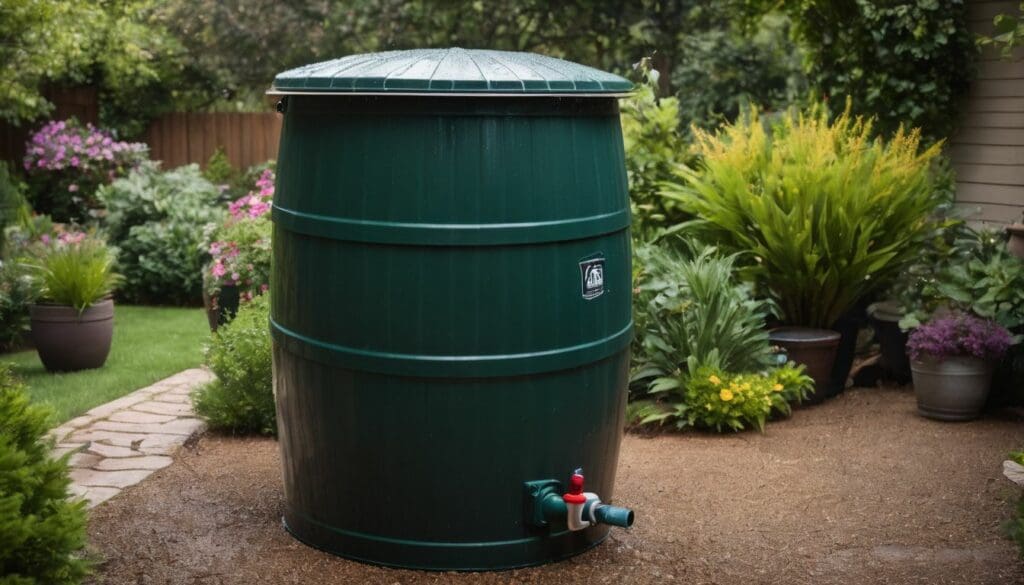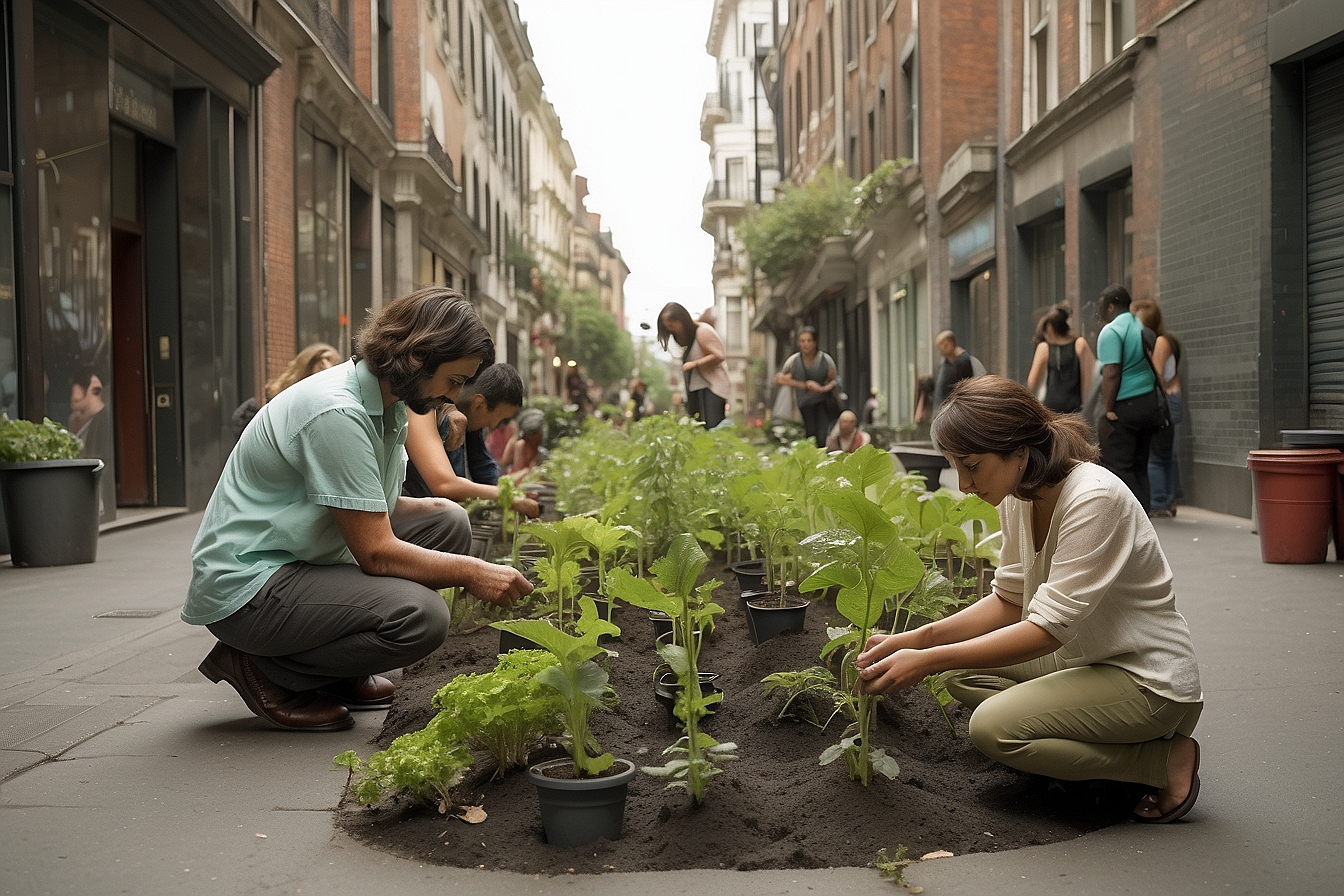Witnessing our beloved gardens eagerly absorbing moisture during those parched periods can genuinely stir concerns about the sustainability of our horticultural pursuits. Like many of you, we have grappled with escalating water bills and have thoroughly searched high and low to discover the most effective watering techniques.
Our forthcoming article is packed with straightforward yet impactful strategies designed to ensure your leafy sanctuary prospers—without recklessly squandering precious resources.
Immerse yourself in our treasure trove of tips for some splash-saving know-how that guarantees not a single drop goes astray!
Key Takeaways
- Adding organic matter to soil, such as compost or manure, increases water retention and helps avoid wasteful runoff. Crop rotation and deep-rooted plants also improve soil health for better water efficiency.
- Watering gardens early in the morning or late in the afternoon reduces evaporation loss. Using precise amounts of water depending on plant needs can prevent both overwatering and underwatering.
- Opting for native plants that are adapted to local conditions can significantly cut down garden watering requirements.
- Collecting rainwater in barrels provides an eco – friendly watering option during dry spells, reducing reliance on treated mains water.
- Mulching with materials like straw or wood chips conserves moisture in the soil, suppresses weeds, prevents erosion and adds nutrients as it breaks down.
Why Water Conservation is Important for Gardens
Water conservation in gardens is crucial for preserving our planet’s valuable resources. Conserving water not only helps to protect the environment, but it also reduces costs and promotes healthy soil and plant growth.
Importance of conserving water
We all recognise the critical role water plays in our gardens, not only as a life source for plants but also as a precious resource that demands careful management. Conserving water sustains healthy ecosystems and ensures future generations can enjoy the natural world just as we do.
With climate change intensifying droughts and depleting water supplies, every drop we save contributes significantly to environmental stewardship.
Our actions directly impact local wildlife habitats and community water levels; therefore, adopting water-saving strategies becomes essential in our gardening practices. Let’s turn our attention towards improving soil health, a fundamental step that goes hand-in-hand with conserving this vital resource in our green spaces.
Ways to Conserve Water in the Garden
Improving soil health, watering at the right time, using the correct amount of water, choosing low-water plants, utilising efficient watering techniques and collecting rainwater are all effective ways to conserve water in your garden.
Read on for more tips on how to save water and maintain a beautiful garden.
Improve soil health
To improve soil health, we can add organic matter like compost or manure to enrich the soil. This will enhance its water-holding capacity and reduce runoff. By practising crop rotation, we can prevent nutrient depletion and promote microbial activity in the soil, thereby maintaining its fertility.
Additionally, avoiding excessive tillage helps retain moisture and preserves soil structure.
We also encourage using cover crops which protect the soil from erosion while adding nutrients upon decomposition. Planting deep-rooted vegetation such as legumes aids in breaking up compacted areas and draws water deeper into the ground.
Water at the right time
Watering your garden at the appropriate time of day helps to reduce water loss due to evaporation. Watering in the early morning or late afternoon allows the soil to absorb moisture efficiently, promoting healthy plant growth while conserving water.
Additionally, watering during these cooler times can prevent potential damage caused by heat stress and fungal diseases in your garden.
Ensuring that you water at the right time also contributes to a more sustainable gardening practice, benefiting both your plants and the environment. By following this simple yet effective technique, you can actively support water conservation efforts in your garden while maintaining beautiful and thriving greenery.
Use the correct amount of water
When watering our garden, it is essential to use the correct amount of water to ensure that plants receive enough moisture without wastage. Overwatering can lead to waterlogged soil and root rot, while underwatering can stress plants and hinder their growth.
To determine the right amount of water needed, consider the type of plant, soil condition, and weather. Deep but infrequent watering encourages stronger root systems and helps plants become more resilient against drought conditions.
Calculating the specific watering needs of each plant in your garden can result in significant water savings over time. By tailoring our approach to meet individual plant requirements, we effectively conserve this precious resource while promoting healthy and thriving greenery in our gardens.
Choose low-water plants
Improving soil health and using the correct amount of water are essential for successful gardening. When considering low-water plants, it’s important to select species that are well adapted to your local climate and soil conditions. Here are some options to consider:
- Succulents: These water-storing plants require minimal watering and thrive in arid conditions.
- Lavender: This fragrant herb is drought-tolerant and adds beauty to any garden.
- Yarrow: With its fern-like foliage and colourful flowers, yarrow is a hardy perennial that doesn’t demand much water.
- Russian Sage: This tough perennial thrives in hot, dry climates and blooms with beautiful purple flowers.
Utilise efficient watering techniques
To ensure efficient watering in your garden, consider the following techniques:
- Use a soaker hose or drip irrigation system to deliver water directly to the roots of plants.
- Adjust sprinklers to minimise overspray and evaporation, targeting the specific areas that need water.
- Water in the early morning or late afternoon to reduce water loss through evaporation.
- Consider using a timer on your irrigation system to control watering times and prevent overwatering.
- Monitor soil moisture levels regularly to determine when and how much water is needed for your plants.
- Group plants with similar water needs together to reduce water wastage.
Collect rainwater and reuse
To conserve water in our garden, we collect rainwater in barrels and reuse it to nourish our plants. This not only reduces the demand on mains water but also provides a free and natural source of hydration for our garden.
By using collected rainwater, we decrease our reliance on treated water, which is especially beneficial during dry periods or droughts.
Additionally, reusing rainwater ensures that our garden receives the purest form of hydration without any added chemicals often found in tap water. It’s a simple yet effective way to support sustainable gardening practices while caring for the environment and reducing our carbon footprint.
Additional Tips for Water-Smart Gardening
Incorporating hardscaping, such as gravel or stone pathways, can help reduce the need for water in your garden. Installing a drip irrigation system can also ensure that water is delivered directly to plant roots, reducing waste and promoting efficient use.
Use native plants
Choosing native plants is a simple yet effective way to conserve water in your garden. Native plants are well-adapted to the local climate and soil conditions, requiring minimal watering once established.
These hardy plants have evolved to survive on natural rainfall, making them low-maintenance and perfect for water-smart gardening. By incorporating drought-resistant native species into your landscaping, you can reduce the need for excessive watering and create a beautiful, sustainable garden that supports local wildlife.
Selecting indigenous plant varieties helps preserve the delicate balance of the ecosystem while promoting biodiversity. Additionally, native plants often require fewer pesticides and fertilisers, further contributing to eco-friendly gardening practices.
Incorporate hardscaping
Incorporating hardscaping features such as pathways, patios, and retaining walls can help reduce water usage in the garden. By using materials like gravel or paving stones for walkways instead of traditional grass paths, you can minimise the need for regular watering and maintenance while still creating a beautiful outdoor space.
Additionally, adding raised beds made from bricks or stone not only adds visual interest to your garden but also helps prevent water runoff and soil erosion.
Constructing a rain garden with strategically placed rocks and boulders can also aid in managing stormwater on your property, reducing the burden on municipal drainage systems. Incorporating these hardscape elements not only contributes to water conservation but also enhances the overall aesthetic appeal of your sustainable landscape design.
Install a drip irrigation system
To maximise water efficiency in the garden, we recommend installing a drip irrigation system. This method delivers water directly to the base of plants, minimising evaporation and runoff.
Drip irrigation ensures that moisture reaches plant roots where it’s needed most, promoting healthy growth while conserving water—a perfect solution for environmentally conscious gardeners seeking sustainable watering techniques.
Utilising a drip irrigation system also supports low-maintenance gardening by automating the precise delivery of water. This eco-friendly approach aligns with our commitment to conservation and environmental responsibility while helping to maintain soil health and reduce overall water consumption in the garden.
Mulching: A Key Water-Saving Technique
Mulching is a key water-saving technique that can help retain moisture in the soil, reduce evaporation, and suppress weed growth. By using organic mulch such as straw or wood chips, you can improve your garden’s water efficiency.
Benefits of mulching
Mulching helps retain soil moisture and regulates temperature.
Different types of mulch
After understanding the benefits of mulching, it’s important to consider the different types of mulch that can be used in your garden.
- Organic Mulch: This type of mulch includes materials like bark chips, straw, and compost. It decomposes over time, enriching the soil with nutrients.
- Inorganic Mulch: Examples include gravel, stones, and landscape fabric. These materials do not break down, providing long-lasting weed control and moisture retention.
- Rubber Mulch: Made from recycled rubber tires, this type of mulch is long-lasting and helps with weed suppression and moisture retention.
- Shredded Leaves: An environmentally friendly option that provides natural nutrients to the soil as it decomposes.
- Pine Bark Nuggets: These nuggets provide excellent insulation for plant roots and gradually decompose to enrich the soil.
- Cocoa Bean Hulls: This aromatic mulch adds a pleasant scent to your garden while also enriching the soil with nutrients.
- Wood Chips: Ideal for pathways or around trees and shrubs, wood chips help retain soil moisture and suppress weeds without robbing nitrogen from the soil.
- Grass Clippings: A cost-effective option for mulching vegetable gardens, grass clippings can add valuable nutrients back into the soil as they break down.
- Newspaper or Cardboard: Excellent for suppressing weeds and retaining moisture in vegetable gardens or flower beds.
- Seaweed Mulch: Rich in trace elements and minerals that benefit plants while also acting as a deterrent for slugs and snails.
How to properly mulch your garden
Properly mulching your garden is crucial for water conservation and soil health. Here are some water-saving techniques for environmentally conscious individuals to consider:
- Choose the right type of mulch for your garden, such as organic materials like wood chips, straw, or compost. Avoid using plastic or rubber mulches that can hinder water absorption.
- Apply a layer of mulch 2 – 4 inches thick around plants to retain moisture in the soil and prevent evaporation.
- Leave a small gap between the base of plants and the mulch layer to allow for air circulation and prevent moisture-related diseases.
- Replenish mulch regularly to maintain its effectiveness, particularly after heavy rainfall or if it starts to decompose.
- Mulch large areas with a mechanical spreader for efficient coverage and consistent depth.
- Aim to mulch your garden in the spring when the soil is moist but not waterlogged, allowing the mulch to trap moisture effectively.
- Water the garden thoroughly before applying mulch to help lock in existing moisture and create a more favorable environment for plant growth.
- Avoid piling up mulch against plant stems or tree trunks as this can lead to rot and encourage pests.
Conclusion
In conclusion, gardeners can make a significant impact on water conservation by implementing simple techniques. By improving soil health, gardening at the right time, and choosing low-water plants, we can save water without compromising our gardens’ beauty.
Utilising efficient watering techniques and collecting rainwater for reuse are key strategies for environmentally conscious gardening. With these tips in mind, we can all contribute to sustainable landscaping practices and support the conservation of our precious water resources.
FAQs
1. How do mulching and composting help save water in my garden?
Mulching and composting can improve soil health, conserving moisture to cut down the need for frequent watering while nurturing your plants.
2. What are native plants, and why should I use them for water-saving?
Native plants are those that naturally thrive in your area; they require less water compared to non-native species and support sustainable landscaping.
3. Can drip irrigation systems make my gardening more water-efficient?
Yes, using a drip irrigation system targets plant roots directly with slow drips of water – this method is highly effective in reducing waste in garden watering.
4. Are there any specific mowing techniques that conserve water?
Mowing your lawn at a higher setting helps protect the soil from sun exposure, which preserves soil moisture and aids in saving water in the garden.
5. What is xeriscaping, and how does it relate to eco-friendly gardening?
Xeriscaping involves designing landscapes to reduce or eliminate the need for excess watering, making it an eco-friendly choice for drought-resistant gardens that save precious resources.





